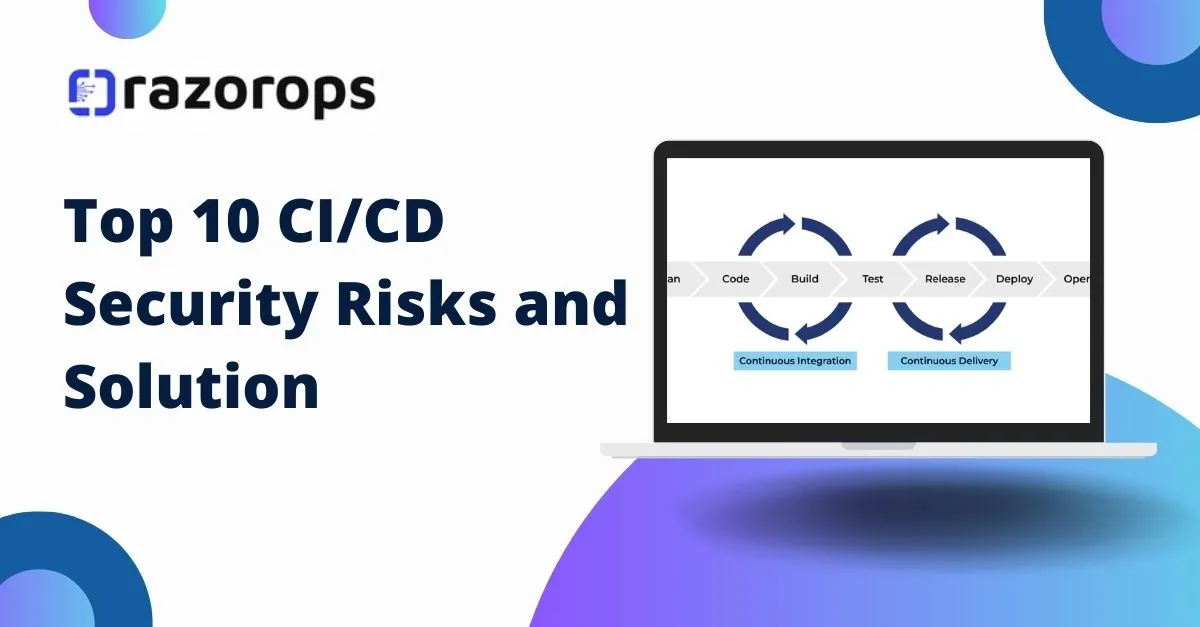Top 10 CI/CD Security Risks and Solution

In the realm of Continuous Integration and Continuous Deployment (CI/CD), security is paramount. However, as organizations rapidly adopt CI/CD practices, several security risks emerge. Understanding and mitigating these risks is crucial to maintaining a secure and resilient software delivery pipeline. Below is a detailed exploration of the top 10 CI/CD security risks.
1: Insufficient Flow Control Mechanisms
Description: Flow control mechanisms in CI/CD pipelines manage the sequence and conditions under which different stages of the pipeline are executed. Insufficient flow control can lead to unauthorized changes, bypassing critical tests, or deploying unverified code.
Risks:
- Unauthorized code changes may be deployed without proper testing.
- Critical stages (like security scans) may be skipped, increasing vulnerability.
Mitigation:
- Implement robust flow control policies that enforce sequential execution of pipeline stages.
- Use condition checks and approvals to ensure that each stage is completed successfully before moving to the next.
- Regularly audit and update pipeline configurations to ensure they adhere to best practices.
2: Inadequate Identity and Access Management
Description: Identity and Access Management (IAM) controls who can access and modify the CI/CD pipeline and associated resources. Inadequate IAM can lead to unauthorized access and potential malicious activities.
Risks:
- Unauthorized users could modify the pipeline or code, introducing vulnerabilities.
- Sensitive information and credentials could be exposed or misused.
Mitigation:
- Implement strict IAM policies with role-based access controls (RBAC).
- Use multi-factor authentication (MFA) for accessing CI/CD tools.
- Regularly review and update access permissions to ensure the principle of least privilege.
3: Dependency Chain Abuse
Description: CI/CD pipelines often rely on external dependencies (libraries, tools, etc.). Dependency chain abuse occurs when malicious actors inject vulnerabilities into these dependencies, which are then propagated through the pipeline.
Risks:
- Compromised dependencies can introduce security vulnerabilities into the application.
- Dependency updates can introduce unexpected behavior or security flaws.
Mitigation:
- Use dependency management tools to track and manage external dependencies.
- Regularly scan dependencies for known vulnerabilities using tools like OWASP Dependency-Check.
- Prefer dependencies from reputable sources and repositories.
4: Poisoned Pipeline Execution (PPE)
Description: Poisoned Pipeline Execution refers to the manipulation of the CI/CD pipeline to execute malicious code. This can occur through compromised build scripts, malicious commits, or tampered build environments.
Risks:
- Execution of malicious code during the build or deployment process.
- Compromise of the build environment or deployed application.
Mitigation:
- Use code signing to verify the integrity of build scripts and artifacts.
- Implement rigorous code review and approval processes for pipeline changes.
- Isolate build environments and use ephemeral build agents to reduce the attack surface.
5: Insufficient PBAC (Pipeline-Based Access Controls)
Description: Pipeline-Based Access Controls (PBAC) regulate access to specific stages and resources within the CI/CD pipeline. Insufficient PBAC can lead to unauthorized access and modifications within the pipeline.
Risks:
- Unauthorized users could access sensitive stages or resources.
- Critical stages could be modified or bypassed.
Mitigation:
- Define and enforce granular access controls for each stage and resource in the pipeline.
- Use environment-specific access controls to restrict access based on deployment environments.
- Continuously monitor and audit access to ensure compliance with security policies.
6: Insufficient Credential Hygiene
Description: Credentials (e.g., API keys, passwords) are often used within CI/CD pipelines to access external services and resources. Insufficient credential hygiene involves poor management and protection of these credentials.
Risks:
- Exposure of credentials can lead to unauthorized access to sensitive systems.
- Compromised credentials can be used to manipulate the CI/CD pipeline or access sensitive data.
Mitigation:
- Store credentials securely using secret management tools (e.g., HashiCorp Vault, AWS Secrets Manager).
- Rotate credentials regularly and enforce strong password policies.
- Limit the scope and permissions of credentials to the minimum necessary.
7: Insecure System Configuration
Description: CI/CD systems and tools must be securely configured to prevent unauthorized access and vulnerabilities. Insecure configurations can expose the pipeline to attacks.
Risks:
- Misconfigured systems can be exploited to gain unauthorized access.
- Insecure configurations can lead to data leaks and system compromises.
Mitigation:
- Follow security best practices for configuring CI/CD tools and environments.
- Regularly review and update configurations to align with evolving security standards.
- Use automated configuration management tools to enforce secure configurations.
8: Ungoverned Usage of 3rd Party Services
Description: CI/CD pipelines often integrate with third-party services for various functionalities. Ungoverned usage of these services can introduce security risks due to lack of oversight and control.
Risks:
- Third-party services may introduce vulnerabilities or data leaks.
- Lack of governance can lead to unauthorized access and misuse of third-party services.
Mitigation:
- Conduct thorough security assessments of third-party services before integration.
- Govern and monitor the usage of third-party services through policies and access controls.
- Prefer services that offer robust security features and compliance certifications.
9: Improper Artifact Integrity Validation
Description: Artifacts produced by the CI/CD pipeline (e.g., binaries, container images) must be validated for integrity to ensure they have not been tampered with. Improper validation can lead to deploying compromised artifacts.
Risks:
- Tampered artifacts can introduce vulnerabilities or malicious code into the application.
- Lack of integrity validation can lead to undetected compromises.
Mitigation:
- Use cryptographic hash functions to validate the integrity of artifacts.
- Implement artifact signing and verification processes.
- Store artifacts in secure repositories with access controls and audit logging.
10: Insufficient Logging and Visibility
Description: Logging and visibility are critical for monitoring the CI/CD pipeline and detecting security incidents. Insufficient logging and visibility can hinder the detection and response to security events.
Risks:
- Lack of logs can make it difficult to investigate and respond to security incidents.
- Insufficient visibility can allow malicious activities to go undetected.
Mitigation:
- Implement comprehensive logging for all stages of the CI/CD pipeline.
- Use centralized logging and monitoring solutions to aggregate and analyze logs.
- Regularly review and audit logs to detect and respond to suspicious activities.
Conclusion
Securing a CI/CD pipeline involves addressing multiple security risks across various stages and components. By understanding these top 10 CI/CD security risks and implementing appropriate mitigations, organizations can ensure a secure and resilient software delivery process. Prioritizing security in CI/CD pipelines not only protects the integrity and confidentiality of the application but also fosters a culture of security within the development and operations teams.



